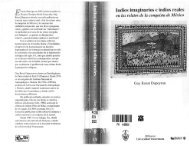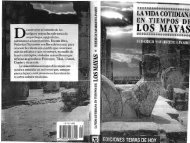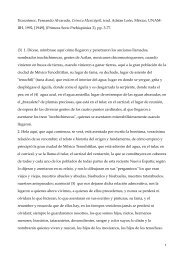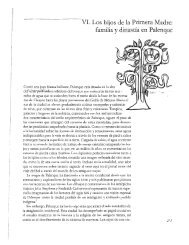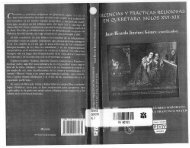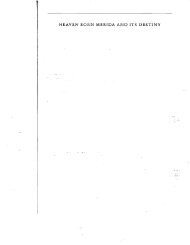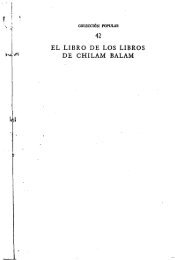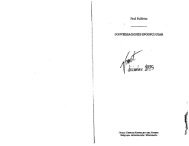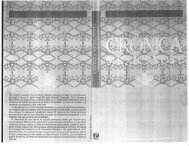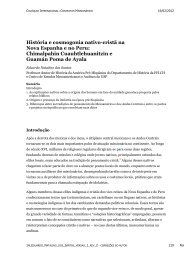1 - Histomesoamericana
1 - Histomesoamericana
1 - Histomesoamericana
You also want an ePaper? Increase the reach of your titles
YUMPU automatically turns print PDFs into web optimized ePapers that Google loves.
Introduction<br />
The Book<br />
The Books of Chilam Balam (Spokesmen of the Jaguar) of the Yucatecan<br />
Maya constitute a treasure-house of historic and ethnographic information<br />
collected by the Maya themselves over a period of many centuries.<br />
They are exasperatingly difficult to translate and interpret for a number of<br />
reasons. They are largely composed in archaic and elliptical language.<br />
Their chronology is obscured by esoteric numerological, astrological, and<br />
religious assumptions. The orthography of the surviving texts leaves a<br />
great deal to be desired. But most of all the Books reflect a world view<br />
and a sense of history that are distinctively Mayan.<br />
An additional complication to the comprehension of these Books is the<br />
fact that they are by no means purely Mayan. They have been shaped by<br />
almost a thousand years of cultural confrontation—five centuries and<br />
more of ideological friction between the Yucatecan heirs to the Classic<br />
Mavan civilization and the invading groups of Náhuatl speakers from<br />
Central Mexico, followed by an almost equal period of conflict and accommodation<br />
between the Mexica-Mayan cultures and the European<br />
civilizations of Spain and Republican Mexico. The resulting history is<br />
dramatic and dynamic and reflects the influence of at least three thoroughly<br />
different cultures.<br />
Among the twelve surviving Books, the Book of Chilam Balam of<br />
Tizimin is the most historical. Others come from Mani, Calkini, Ixil,<br />
Chumayel, Kaua, Teabo (three of them), Tekax, Oxkutzcab, and Tusik.<br />
The Tizimin was collected by the parish priest of Tizimin, Manuel Luciano<br />
Pérez, who sent it to his bishop in Merida in 1870 with the remark<br />
that it had been in his possession for a number of years [muy buenos<br />
años) (Barrera 1948:291). The original is now in the Museo Nacional de<br />
Antropología in Mexico City. I have worked from a photostatic copy in<br />
the Latin American Library at Tulane University. All of the forty-two<br />
texts of the Tizimin except chapters 9 and 22 to 25 are parallel to passages<br />
in one or more of the other Books—those of Mani, Chumayel, or<br />
Kaua, all of which include additional materials of a less historical order:<br />
medical, exegetical, astronomical, liturgical, or literary. Taken by itself,<br />
however, the Book of Tizimin constitutes an outline history of Yucatan<br />
from the seventh century to the nineteenth, with explicit coverage of<br />
each katun (approximately twenty years) from 1441 to 1848.<br />
This is history in the Mayan manner. It is dominated by a sense of<br />
cyclical repetition and by a profound faith that correct calendrical calculation<br />
will enable the priests to predict the fate of the next cycle. In most<br />
opposite: Tizimin geography instances the cycle in question is that of the katun, a period of 7,200 days<br />
XI



